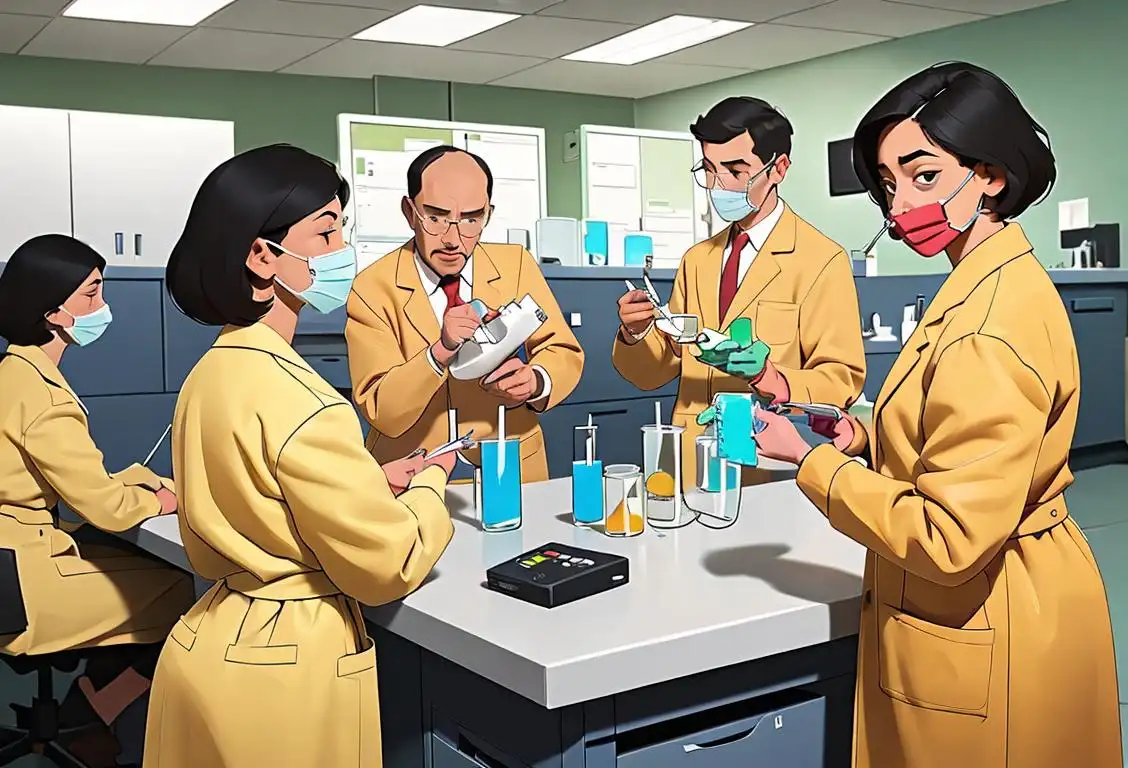National Toothbrush Day

Welcome to National Toothbrush Day, my friends! Prepare to be dazzled by the enchanting history of this humble dental tool.
When is Toothbrush Day?
It's national toothbrush day on the 26th June.
The Evolution of the Toothbrush
Ah, the toothbrush. The trusty companion that helps us start our day with a sparkling smile. But have you ever wondered how it came to be? Well, let's dive into the fascinating journey of the toothbrush.
Believe it or not, the concept of cleaning teeth dates back thousands of years. Ancient civilizations, like the Egyptians and Babylonians, utilized twigs with frayed ends to scrub their pearly whites (or not-so-pearly yellows). It wasn't the most luxurious dental experience, but hey, they were onto something.
The modern toothbrush as we know it didn't make its grand entrance until the 15th century. The Chinese get the credit for inventing the first bristle brush. These bristles were crafted from the hair of pigs attached to handles made from bone or bamboo. Talk about a stylish upgrade from twigs!
Fast forward to the 18th century, and the toothbrush started to gain popularity across Europe. However, only the very well-to-do had access to these fancy mouth cleaners. The bristle brushes were imported from China and were quite expensive—definitely not your average drugstore purchase.
It wasn't until the early 1900s that toothbrushes became more affordable and widely available. Thanks to the invention of nylon, bristles could be produced at a lower cost. And thus, the toothbrush revolution began, making oral hygiene accessible to the masses!
The Power of a Healthy Smile
Celebrating National Toothbrush Day isn't just about honoring the history of this marvelous invention—it's also a reminder of the importance of dental care. Taking care of our teeth is vital for overall health and well-being.
A healthy smile not only boosts self-confidence but also prevents a whole slew of dental issues. Gum disease, cavities, and even heart disease can all be linked to poor oral hygiene. So, my friends, let's take a moment to appreciate our toothbrushes and the magical job they do in keeping our chompers in tip-top shape!
History behind the term 'Toothbrush'
1498
Early Bristle Brushes
In the year 1498, bristle brushes were first mentioned in Chinese literature. These brushes were made by attaching coarse hairs from boar and hog jaws to a handle made of bone or bamboo. They were primarily used for cleaning and grooming purposes, and their bristles were not as soft as the ones we have today.
1498
Discovery of the first toothbrush
The first known toothbrush was discovered in China during the Tang Dynasty. It consisted of a handle made from bamboo or bone with bristles made from the stiff hairs of a boar. Toothbrushing was not a common practice at this time and was mainly done by the elite.
1498
Early Toothpicks
In the year 1498, during the Ming Dynasty in China, the first known precursor to the toothbrush was used. These were thin sticks made of bamboo or bone, called "chewing sticks" or toothpicks. They were used to remove food particles from between teeth.
1498
Practical Origins
In the year 1498, the first precursor to the toothbrush was introduced by the Chinese. This early version consisted of a handle made of bamboo or bone with bristles made from the stiff hairs of hogs, horses, or badgers. While not as efficient as modern toothbrushes, this invention marked the practical beginnings of oral hygiene tools.
1498
The First Bristle Brushes
In the year 1498, the term 'toothbrush' had not yet come into existence. However, this is the year when the concept of brushing teeth with bristles was first documented. The Chinese used coarse boar hairs attached to bamboo or bone handles as dental cleaning devices. These early bristle brushes were effective in removing food particles and maintaining oral hygiene.
1780
The Birth of Modern Toothbrush
In the year 1780, an Englishman named William Addis changed the toothbrush game forever. While in prison, Addis carved a bone handle and used boar bristles he had obtained from a guard to create the first modern toothbrush. This innovative design replaced the previous practice of using cloth or sponge to clean teeth, and it laid the foundation for the toothbrush as we know it today.
1780
The First Patent
In 1780, the first known patent for a toothbrush was granted to William Addis, a British entrepreneur. With the invention of machinery and the use of bone handles to anchor boar bristles, the modern toothbrush began to take shape. Addis's design was revolutionary, marking a significant turning point in toothbrush history.
1780
Introduction of the modern toothbrush
The modern toothbrush, as we know it today, was first introduced by an Englishman named William Addis. While serving time in prison, Addis carved a handle from bone and used swine bristles for the bristles. This design laid the foundation for future toothbrushes.
1780
First Mass-Produced Toothbrush
In the year 1780, William Addis, an English entrepreneur, invented and mass-produced the first modern-style toothbrush. The handle was made of cattle bone with boar bristles attached to it. This marked a significant shift from using improvised tools to a more standardized tooth-cleaning device.
1780
The Birth of Modern Toothbrush
Jumping ahead to the year 1780, the first modern toothbrush, as we know it today, was invented. William Addis, an Englishman, is credited with creating the first mass-produced toothbrush. It featured a handle made of animal bone and bristles made from the hair of horses or pigs. This milestone marked a significant advancement in dental care and laid the foundation for the toothbrush as an essential tool for oral hygiene.
1857
Nylon Bristles Revolutionize Dental Care
The year 1857 witnessed a significant revolution in dental care with the invention of nylon bristles by DuPont. Before nylon, toothbrush bristles were made from animal hair, which were not always the most hygienic option. The introduction of nylon bristles provided a more consistent, durable, and hygienic alternative, contributing to improved oral hygiene worldwide.
1857
Nylon Bristles Introduced
In the year 1857, H.N. Wadsworth, an American dentist, introduced the concept of using nylon bristles for toothbrushes. This innovation made toothbrushes more effective as the nylon bristles were finer and softer than the previous boar or horsehair bristles.
1857
The Birth of Nylon Bristles
Nearly a century after the initial invention, in 1857, the first toothbrush with nylon bristles was produced. Mass production of toothbrushes became possible with the introduction of nylon, a synthetic material developed by DuPont. This breakthrough not only improved the durability and lifespan of toothbrushes but also marked a shift away from using animal hair for bristles.
1898
The first mass-produced toothbrush
In the late 19th century, the mass production of toothbrushes began. H.N. Wadsworth obtained the first patent for a toothbrush in the United States in 1857, but it was not until 1898 that the first mass-produced toothbrushes hit the market.
1857
Nylon Bristles Replace Animal Hairs
Fast forward to 1857 when the toothbrush underwent another transformative change. Up until this point, bristle brushes still utilized animal hairs. However, the introduction of nylon bristles revolutionized toothbrushes. Dupont de Nemours, a chemical company, introduced nylon as a substitute for natural bristles. Nylon bristles were more durable, easily molded, and provided better oral cleaning. This innovation greatly improved the effectiveness and longevity of toothbrushes.
1938
Nylon bristles replace boar's hair
Until the late 1930s, toothbrush bristles were primarily made from animal hair, including boar's hair. However, in 1938, DuPont introduced nylon bristles, which were more hygienic, durable, and affordable. This innovation revolutionized toothbrush manufacturing.
1938
Electric Toothbrush Era Begins
In 1938, the first electric toothbrush was introduced in Switzerland by Dr. Philippe-G. Woog. This revolutionary device utilized vibrations and oscillations to clean teeth more effectively than manual brushing. While electric toothbrushes gained popularity over time, they were initially regarded as a luxury item due to their high cost.
1938
The First Electric Toothbrush
In 1938, the first electric toothbrush was invented by Dr. Philippe-Guy Woog in Switzerland. Initially developed for patients with limited motor skills, the electric toothbrush quickly gained popularity among the general population. The electric toothbrush offered enhanced convenience and provided a more efficient cleaning experience.
1938
Toothbrush with Synthetic Bristles
In the year 1938, the first toothbrush with synthetic bristles was produced by Dupont de Nemours. This marked a major advancement in dental hygiene as synthetic bristles were more hygienic, durable, and could be manufactured in various shapes and sizes.
1938
The First Electric Toothbrush
In 1938, the first electric toothbrush was introduced to the market. Known as the 'Broxodent,' this electric toothbrush was developed in Switzerland. It was a significant invention that simplified toothbrushing and made it more accessible to people with limited dexterity. Over the years, electric toothbrushes have evolved with advanced features like oscillating or sonic movements, timers, and pressure sensors, further enhancing oral hygiene routines.
1960
Toothbrush Innovations Continue
The 1960s witnessed further advancements in the toothbrush industry. Companies began introducing softer bristles to prevent gum damage and tooth enamel abrasion. Moreover, ergonomic handles and toothbrush designs tailored to the human hand's shape emerged, enhancing user experience and comfort during brushing. These innovations continue to improve the effectiveness of toothbrushes and promote oral health.
1960s
Advancements in Toothbrush Design
The 1960s marked a period of numerous advancements in toothbrush design. Innovations such as angled bristles, rounded heads, and softer bristle materials made brushing more comfortable and efficient. These improvements aimed to provide a better cleaning experience while minimizing potential damage to the gums and tooth enamel.
1960
The first electric toothbrush
The first electric toothbrush, known as the Broxodent, was introduced to the market in 1960. It was powered by a plug-in cord and consisted of a rotating head that helped automate the brushing process.
1960s
Advancements in Design
Throughout the 1960s, toothbrush design underwent significant advancements. Nylon bristles were further refined for improved cleaning efficiency, and handles were made more ergonomic for better grip and control. These design innovations ensured that toothbrushes became more effective, comfortable, and accessible to a wider audience.
1960
Electric Toothbrush Invention
In the year 1960, the first electric toothbrush was invented in Switzerland. It was created by Dr. Philippe-Guy Woog and required a power source to rotate the bristles. Electric toothbrushes revolutionized oral care by providing automated brushing motions and making dental hygiene more accessible to people with limited dexterity.
1992
Changing Bristle Color
In the year 1992, the first toothbrush with color-changing bristles was introduced. This innovative design feature indicated when it was time to replace the toothbrush by fading the color of the bristles. This development helped people maintain better oral health by ensuring timely toothbrush replacements.
1987
Interdental Brushes Enter the Scene
In 1987, interdental brushes became widely available for cleaning between teeth and along the gum line. These small brushes with long, thin handles made reaching tight spaces easier and helped tackle plaque and debris in areas that regular toothbrushes often missed. They have since become an important tool in oral hygiene routines.
1980s
Introduction of the Modern Toothbrush
By the 1980s, the modern toothbrush had become commonplace worldwide. Manual toothbrushes with various bristle configurations, handle shapes, and sizes were readily available and widely used. Oral hygiene had become a significant aspect of daily self-care routines, with the toothbrush being a symbol of dental well-being and cleanliness.
1992
Introduction of the ultrasonic toothbrush
The ultrasonic toothbrush was introduced in 1992 by Dr. Phillippe-Guy Woog. This toothbrush used ultrasound waves to create high-frequency vibrations that could remove plaque and bacteria more effectively than traditional toothbrushes.
Present
Continuing Evolution and Personalization
In the present day, toothbrushes have evolved into a variety of forms, including manual brushes, electric toothbrushes, sonic toothbrushes, and even smart toothbrushes with integrated technology. Toothbrush designs range from traditional handheld brushes to ultra-compact and travel-friendly options. Additionally, advancements in materials, bristle technologies, and manufacturing processes allow for enhanced plaque removal and personalized brushing experiences. The term 'toothbrush' has become synonymous with oral hygiene, contributing to healthier smiles worldwide.
21st Century
Technological Advancements and Smart Toothbrushes
The 21st century witnessed an explosion of technological advancements in the dental industry. Smart toothbrushes emerged featuring features like Bluetooth connectivity, pressure sensors, timers, and even artificial intelligence. These high-tech brushes offer real-time feedback to users, helping improve brushing techniques and monitor oral health more effectively.
Present
Continued advancements in toothbrush technology
In the present day, toothbrush technology continues to advance. We now have toothbrushes with built-in timers, pressure sensors, and even Bluetooth connectivity to track brushing habits. The goal is to make oral hygiene more effective and enjoyable for everyone.
Did you know?
Did you know that the average person spends approximately 38.5 days brushing their teeth over their lifetime? That's almost a full month dedicated to oral hygiene!Tagged
awareness healthFirst identified
26th June 2015Most mentioned on
26th June 2015Total mentions
99Other days
Kale Day
School Nurse Day
Drug Test Day
Women Physicians Day
Fitness Day
Prescription Drug Take Back Day
Doctors Day
Hiv Testing Day
No Bra Day
Lash Day









